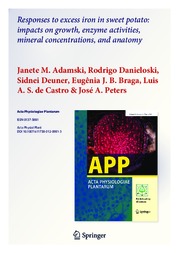Responses to excess iron in sweet potato: impacts on growth, enzyme activities, mineral concentrations, and anatomy.
Responses to excess iron in sweet potato: impacts on growth, enzyme activities, mineral concentrations, and anatomy.
Author(s): ADAMSKI, J. M.; DANIELOSKI, R.; DEUNER, S.; BRAGA, E. J. B.; CASTRO, L. A. S. de; PETERS, J. A.
Summary: This study aimed to evaluate the effects of different iron concentrations on growth characteristics, antioxidant enzyme activities, nutrient absorption, and anatomical changes in sweet potato (Ipomoea batatas L.). To accomplish this, seedlings from apical branches of plants that had already been established in the greenhouse were rooted in a hydroponic sponge and then transplanted into a hydroponic system intermittently for 2 weeks and irrigated with nutrient solutions containing iron (ferric-EDTA) at concentrations of 0.45, 0.9, 4.5, and 9.0 mmol L?1. Height, leaf area, and total biomass were significantly reduced at iron concentrations of 4.5 and 9.0 mmol L?1. The iron concentrations in the established leaves and those that developed after the solution supplementation increased significantly. The amounts of other nutrients were also affected, with manganese showing the most significant decrease. The activities of the antioxidant enzymes, superoxide dismutase, and ascorbate peroxidase increased in plants grown in the 9.0 mmol L?1 iron solution. At this concentration, however, the stomatal densities were reduced on the abaxial surfaces of the leaves, although the stomatal diameters increased. The ultrastructures of the radical cells showed mitochondrial impairment at high iron concentrations; however, the chloroplast structures remained unaffected.
Publication year: 2012
Types of publication: Journal article
Keywords: Batata, Biomassa, Estresse, Ferric-EDTA, Ferro, Ipomoea batatas L, Nutrientes, stomata
Observation
Some of Embrapa's publications are published as ePub files. To read them, use or download one of the following free software options to your computer or mobile device. Android: Google Play Books; IOS: iBooks; Windows and Linux: Calibre.
Access other publications
Access the Agricultural Research Database (BDPA) to consult Embrapa's full library collection and records.
Visit Embrapa Bookstore to purchase books and other publications sold by Embrapa.

